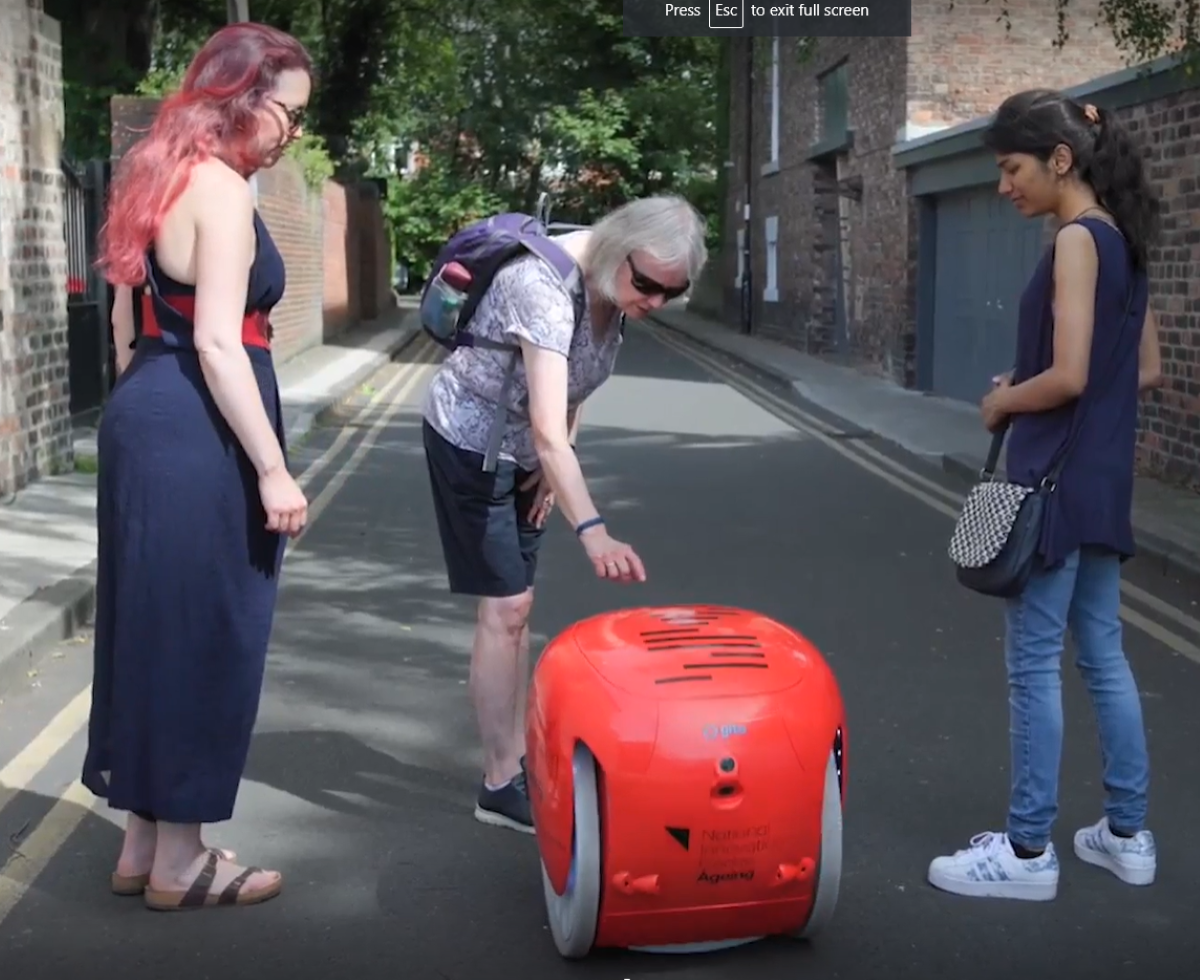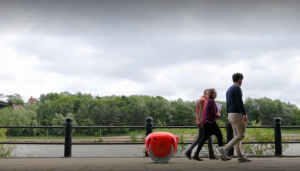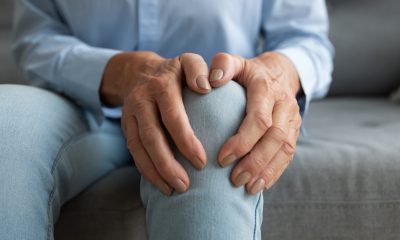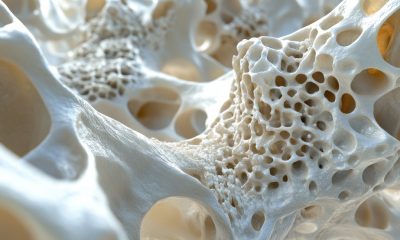Technology
The robot companion that could soon be helping older people age better

A cargo-carrying robot that follows you around could be the answer to promoting healthy ageing.
Research carried out by Newcastle University in the UK has shown the gita robot (pronounced jee-ta and spelt with a lowercase ‘g’) can support the mobility and wellbeing of older people.
The findings of the world-first citizen-led study have revealed gita – which looks like an over-sized medicine ball on wheels and has been designed to follow humans – has the potential to help alleviate loneliness in independent older people by prompting conversations and social interaction, as well as encouraging walking, and fostering independence and more sustainable living.
Dr Shuo Li, a research associate at Newcastle University’s School of Engineering, and lead author of the study, said it “demonstrates how future mobility and robotic innovations have the potential to address the global challenge of ageing.”
Designed by Boston-based robotics company Piaggio Fast Forward and backed by the Piaggio Group – the makers of the iconic Vespa scooter – gita was launched onto the US market in 2019 to help make everyday life easier, smarter, and more fun for humans of all ages.
Its sole purpose is to follow people wherever they go. Moving at a speed of up to six miles an hour and able to carry a load of 18kg in its internal cargo compartment, gita communicates through sound, light, touch and 360-degree vision.
Whilst gita can’t climb stairs, it can move around buildings with lifts and ramps as well as hard surfaces like pavements.
With one in six of the world’s population predicted to be aged over 65 by 2050 and growing numbers of older people needing care, the team at Newcastle University spotted the potential for gita robots to help foster more independent and sustainable living, as well as potentially lessening the effects of loneliness and isolation.
The researchers showed videos of an older adult interacting with the gita robot in a real-world setting to a group of study participants with an average age of 75, and analysed their feedback and requirements.
They indicated that the robot would physically support them when out for a walk, removing the need to carry things like groceries, and even acting as a seat. Several participants also suggested the robot could be useful for carrying items to help support them whilst out for a walk.
According to the Newcastle University team the results have also shown that gita can facilitate social interactions, such as gaining potential attention and acting as a talking point to help kickstart conversations.

A gita robot being trialled in Newcastle in the UK
Other aspects the researchers investigated included the perceived benefits for others in the community, any issues of the human-following robots, and requirements for improvements.
Many of the participants suggested they did not yet need the support of a human-following robot, given that they could still carry belongings or drive, but indicated it could be useful for maintaining their mobility and independence if their health were to decline or their circumstances changed in the future.
Follow-up research is now underway to examine and quantify older adults’ interaction with a human-following robot in a real-world context.
The study has been published in the journal Nature Scientific Reports and is based on final-year research undertaken by former Master of Engineering (Meng) student, Kirsty Milligan, who was supervised by Professor Phil Blythe and Dr Shuo Li.
The civil engineering graduate said: “My research project was a valuable opportunity for me to try something a bit different as part of the final year of my MEng degree, and it was really interesting to explore whether such an innovative technology has the potential to support active ageing.
“I enjoyed talking to the participants and hearing their thoughts on the robot, as well as learning more about research methods and qualitative data analysis.
“It is really exciting that a paper based on my work has been published, and I hope it inspires others to further explore the use of these types of technologies by older people.
“I’ll be interested to see where future research in this area goes, and if maybe we will see these types of robots in everyday use one day.”
The gita robots are being tested by the team at the National Innovation Centre for Ageing (NICA) on Tyneside, a world-leading organisation supported by an initial investment from the UK government and Newcastle University, which is looking at ways of co-developing and bringing to market products and services to create an environment in which people can live better for longer.

Gita will follow behind and can carry up to 18kg of belongings
NICA’s director and one of the study’s co-authors is Professor Nic Palmarini. He said: “This is an example of how emerging technologies can help tackle and mitigate isolation and support older adults’ engagement in outdoor activities, a crucial driver to population’s health and longevity.
“This is a great example of what we have defined as ‘ageing Intelligence’ at work and is part of our wider research on supporting mobility for our older citizens.”
Phil Blythe, professor of Intelligent Transport Systems, and head of the Future Mobility Group at Newcastle University, who also co-authored the study, added: “We believe that research into supporting the mobility of older people and ensuring they have transport systems and services that are fit for purpose is critical for a fair and levelled up society.
“This is one of the key areas of my group’s research where we are always looking for future technologies that can improve the mobility of all.”
The researchers argue that while these robots offer advantages, there is a need for additional improvements to their design to fully support older people.
They say it is crucial to take into account the needs and demands of older individuals when creating and advancing age-friendly robots that can follow humans.
Limitations highlighted in the study include the possible negative interactions between the robot and others. The researchers suggest considering future iterations of the robot that address these concerns, such as implementing a security system that connects to a remote operator.
According to the study’s results, robot developers and innovators must focus on improving the robots’ ability to navigate kerbs, steps, and diverse terrain for them to be practical for most elderly people.
News
Supplement could restore memories lost by Alzheimer’s, study finds

A naturally occurring supplement could restore memory loss in Alzheimer’s, a mouse study using human gene mutations suggests.
Nicotinamide adenine dinucleotide (NAD+) is a molecule vital for energy production, DNA repair and cellular health, often discussed by longevity specialists as a tool against age-related disease.
Researchers have discovered it can protect the brain from degeneration caused by Alzheimer’s disease.
Lead author Dr Alice Ruixue Ai, an Alzheimer’s researcher at the University of Oslo, said: “Preliminary studies have shown that supplementation with NAD+ precursors, such as (NR) or nicotinamide mononucleotide (NMN), can offer therapeutic benefits in AD [Alzheimer’s disease] animal models and early clinical trials.
“However, the molecular mechanisms behind these benefits remain largely unclear.”
NAD+ naturally declines with age, and it is believed that poor lifestyle choices — including eating a highly processed diet, smoking, drinking alcohol and getting sunburnt — can further diminish the body’s reserves.
The team engineered mice to carry the human Tau P301S mutation that causes neurodegeneration and memory loss.
These mice showed clear memory deficits in a standard behavioural test.
When they gave the mice nicotinamide mononucleotide, a compound that raises NAD+ levels, they found evidence that memory performance returned to normal.
In Alzheimer’s disease, abnormal tau — a misfolded protein that clumps in the brain — is a hallmark of the condition.
The team’s research suggests NAD+ acts through a previously unidentified RNA splicing pathway. RNA carries instructions for building proteins; RNA splicing is the natural editing step that shapes those instructions.
They first saw age-related changes in RNA splicing in a species of worm, then showed that NAD+ could correct splicing problems driven by toxic tau.
Tests in mice indicated this pathway is regulated by a protein called EVA1C, which plays a key role in RNA splicing.
When NAD+ levels rise, EVA1C helps correct splicing errors. This restoration process, involving hundreds of genes, may help reverse damage caused by tau.
Associate professor Evandro Fei Fang-Stavem, said: “Notably, we found when the EVA1C gene was knocked down, these benefits were lost, confirming that EVA1C is essential for NAD+ mediated neuroprotection.
“We propose that maintaining NAD+ levels could help preserve neuronal identity and delay cognitive decline, paving the way for combination treatments to enhance RNA splicing,” added Dr Ai.
NAD+ has gained popularity among longevity enthusiasts and celebrities.
In 2022, Hailey Bieber and Kendall Jenner discussed NAD+ IV drips in the first series of The Kardashians.
NAD+ infusion treatments are available in the UK at specialised wellness clinics.
There are also NAD+ supplements, kits and at-home injections emerging on the market.
Biohacker and longevity entrepreneur Bryan Johnson — who is 47 but claims to have the biological markers of a man in his 30s — also includes NMN supplements in his anti-ageing regimen.
News
Forus gains AI backing with 21 per cent stake

Eye-screening firm Forus Health has received a 21 per cent investment to scale its AI diagnostics across India and abroad.
Forus Health develops ophthalmic diagnostics — tools that detect eye disease — and “oculomics”, which uses eye images to flag wider risks such as diabetes or hypertension. Its devices have screened over 22 million people in more than 75 countries, and its AI-integrated platform has delivered comprehensive eye assessments to over five million patients.
The deal is a secondary transaction intended to support the scale-up of Forus Health’s AI eye-screening platforms and international deployment.
Inviga Healthcare Fund has acquired the 21 per cent stake, its second major investment after Mynvax in 2024, signalling support for India-built AI diagnostics in global markets.
Dr B. S. Ajaikumar, founder of Inviga Healthcare Fund and chair of HCG, said: “Forus Health embodies the Inviga ethos: clinically strong, technologically deep, socially impactful, growth oriented, profitable. This investment is a testament to our confidence in India’s ability to produce world-class healthcare innovations for domestic and international markets. We are delighted to partner with visionary founders like Chandrasekhar (KC) who combine deep insight with execution to make preventive, equitable healthcare a reality.”
K. Chandrasekhar, founder and chief executive of Forus Health, said: “We are thrilled to welcome Inviga as we enter the next phase of our growth. Their expertise in healthcare, operational experience, and insights from a clinician’s perspective are incredibly valuable. Together, we aim to enhance our AI and platform capabilities, utilise our proven ability to innovate in medical devices, and expand our reach both in India and globally. Our mission remains focused on eradicating preventable blindness.”
Rakshith Rangarajan, fund manager at Inviga Healthcare Fund, said: “Our collaboration with Forus is a strategic step intended to facilitate the expansion of a reputed med-tech franchise that is serving a significant market demand through a sustainable and economically sound business model. It reflects our commitment to advancing accessible solutions that address large, unsolved health challenges. The Make in India, Make for India and Make for the World ethos of Forus resonates deeply with our Fund. We’re confident this partnership will drive sustained growth and long-term value creation.”
The burden underscores the need for scalable tools: an estimated 270 million people in India live with visual impairment, much of it preventable; globally, 2.2bn people live with vision impairment or blindness, with over 1bn cases considered preventable or treatable. Forus Health’s 3nethra screening devices and wearable 3nethra specto — a smartphone-operated digital refractor for remote and tele-optometry — target earlier detection and easier access to care.
News
Scientists closer to halting ageing at its biological roots

British scientists are preparing human trials of an anti-ageing pill, claiming they can curb age-related tissue decline.
The team says research has found a way to block necrosis — uncontrolled cell death linked to many age-related diseases.
If successful, doctors could move beyond treating symptoms of ageing to targeting the biological processes that cause it.
British biotech company LinkGevity is preparing to trial what its founders describe as potentially the world’s first drug designed to slow the ageing process, after patenting its experimental drug and completing lab work.
The team is now awaiting regulatory approval for human trials involving kidney-disease patients. It is hoped these will begin in the UK, US and Europe within months — the first real-world test of what the founders call “anti-necrotic therapy”.
Scientists hope that by halting uncontrolled cell death, they will prevent or delay many diseases of old age, including heart failure, liver disease, kidney disease, Parkinson’s, strokes and dementia.
Professor Justin Stebbing, a cancer and cell death expert at Imperial and Anglia Ruskin University who is an adviser to the company, said: “Necrosis sounds like a biology term, but what it really means is tissue rot,”
“If you can prevent that, you don’t just look younger – your organs actually stay younger.”
He added: “No regulator has approved a drug for ageing because it’s difficult to be clear about what end points you’re going to use in studies and how to measure it.
“We’re using the kidney as a model, and we think we have a good chance of being the first anti-ageing drug approved, because we understand the mechanism that we’re dealing with here, and we understand how to stop it.”
The company is supported by Innovate UK, the UK government’s innovation agency, which funds research and development. It also receives backing from Horizon Europe, the EU’s main funding programme for research and innovation, and the Francis Crick Institute, a biomedical research centre based in London.
LinkGevity’s work has also attracted interest from NASA and the European and UK Space Agencies, which are studying how microgravity affects human biology.
The company was founded by sisters Dr Carina Kern, chief executive of LinkGevity, and Serena Kern-Libera, who left established careers to pursue longevity science.
Dr Kern describes the field as restorative medicine: “The body is an interconnected network.
“We’re not just targeting a symptom – we’re targeting the process that drives ageing itself.”
Dr Kern, a former research fellow in ageing-associated disease at University College London, leads LinkGevity’s scientific programme.
Ms Kern-Libera, a lawyer who previously worked at the Bank of England, manages business strategy and partnerships.
“We’ve never before been able to intervene in this type of cell death,” says Dr Kern.
“If we can stop necrosis, we can preserve tissue for longer – and that could mean healthier, longer lives.”
Each day, billions of cells in the human body die and are replaced. Most follow a safe, orderly process called programmed cell death, which removes harmful cells and supports healing and development.
Necrosis, by contrast, is uncontrolled — cells swell, rupture and spill toxic contents that inflame and damage surrounding tissue.
Over time, this “undesirable” and “messy” form of cell death contributes to organ failure, heart disease, dementia and the general tissue decline associated with ageing.
“Necrosis underlies tissue degeneration,” said Serena Kern-Libera. “It’s not limited to one disease. It’s something that happens across the biological system.”
LinkGevity’s research focuses on the calcium pathways that trigger necrosis. Its patented compound is designed to block the calcium overload that causes cell membranes to burst and die.
The firm’s first human trial will focus on patients with kidney disease — one of the organs most vulnerable to necrosis and age-related decline. If successful, they then hope to use the drug as a broader anti-ageing therapy.
NASA believes LinkGevity’s work could also help improve the lives of astronauts.
In space, astronauts lose muscle mass, bone density and calcium balance — changes that mirror aspects of accelerated ageing.
These conditions make astronauts an ideal model for studying tissue degeneration.
Professor Damien Bailey, chair of the Life Science Working Group at the European Space Agency, said: “When astronauts return to earth they are treated much like patients. If a drug can make our cells more resilient, it could be a gamechanger for both space travel and human health on earth.”
The Cambridge start-up is part of a global race to develop therapies that slow ageing.
In the US, billionaire-backed ventures such as Altos Labs (funded by Amazon founder Jeff Bezos), Retro Biosciences (backed by OpenAI’s Sam Altman) and Calico Life Sciences (created by Google’s parent company, Alphabet) are all pursuing ways to rejuvenate human cells.
British firms are investigating cell-reprogramming technologies. LinkGevity, however, takes a simpler approach — focusing not on altering genes but on preventing the destructive cell death that leads to organ decline — letting the body’s normal function restore itself.
Analysts estimate the global longevity market at around £25bn.

 News2 months ago
News2 months agoBone breakthrough could reverse osteoporosis

 Research1 month ago
Research1 month agoMost Americans would be considered obese under new guidelines

 Research2 weeks ago
Research2 weeks agoResearcher wins grant for tissue ageing study

 News2 months ago
News2 months agoResearch uncovers ageing secrets of world’s oldest woman

 News3 weeks ago
News3 weeks agoJust 30 mins of light activity can boost energy and mood, study finds

 News4 days ago
News4 days agoSupplement could restore memories lost by Alzheimer’s, study finds

 News1 month ago
News1 month agoDementia scan could boost UK diagnosis rates

 News3 weeks ago
News3 weeks agoBlueprint raises US$60m for longevity platform







































